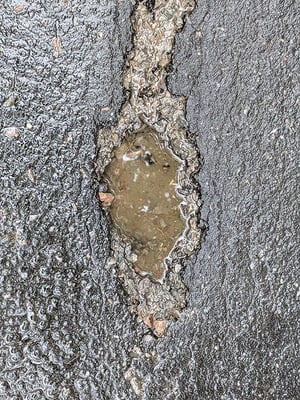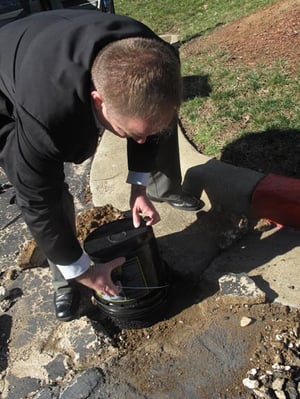Pothole Repair: How You Can Save Money
 Potholes blight an otherwise immaculate landscape, whether they appear on a driveway or a parking lot. When hiring contractors to do the repairs, you are faced with either high costs or shoddy work that won't last for long. As they say, if you want something done well, do it yourself. Knowing how to fill potholes yourself saves you money and protects your property. This is the first thing that you can do to save money on pothole repairs.
Potholes blight an otherwise immaculate landscape, whether they appear on a driveway or a parking lot. When hiring contractors to do the repairs, you are faced with either high costs or shoddy work that won't last for long. As they say, if you want something done well, do it yourself. Knowing how to fill potholes yourself saves you money and protects your property. This is the first thing that you can do to save money on pothole repairs.
Whether you are a homeowner or a business owner whose property includes an asphalt driveway or parking lot, maintenance issues associated with asphalt surfaces, wherein one of the most common is pothole repair, will have to be dealt with on a regular basis. With this in mind, it would make sense to invest in some tools and materials necessary for these repairs so that you can do them yourself instead of hiring contractors every time a pothole appears.
Table of Contents
What’s The Hurry?
 Asphalt pothole repair is such a simple thing to do. Getting it done now, before snow and ice set in, is the very best thing you can do for your driveway or parking lot. It prevents and protects from further damage, saving you very costly repairs in spring.
Asphalt pothole repair is such a simple thing to do. Getting it done now, before snow and ice set in, is the very best thing you can do for your driveway or parking lot. It prevents and protects from further damage, saving you very costly repairs in spring.
First of all, there’s the danger of snow removal, whether by plow or shovel. Any equipment is going to get hung up on the edges of the hole and rip out more chunks of asphalt. Let’s not mention the damage that can happen to plows and shovels! In turn, these craters can cause damage to any vehicles unlucky enough to hit them. And let’s not forget the pedestrians walking along either.
The most neglected reason to do asphalt pothole repair is the damage caused by the freeze and thaw cycles. The running melt-water erodes the very foundation of your blacktop to create more sinkholes. The freeze cycles cause the chuck holes and cracks to expand and widen the damage. Instead of “lather, rinse, repeat”, you end up with “freeze, crack expands, thaw, foundation erodes, and repeat” for the whole winter.
This is the truly great news: it’s not too late. The modern cold patch for asphalt pothole repair can be used at any temperature, and in any weather. You can breathe a sigh of relief now, and finish reading to learn how to fix chuck holes quickly, easily, and with as good a finish as when the pros do it.
Sunk Cost of Potholes - Infographic
As an asphalt sealcoat professional, one thing I find really frustrating is looking at preventable damage. So many parking lots, driveways and roadways could be saved with just a small amount of preventative maintenance. Think I’m exaggerating? Look at this infographic we put together on the sunk cost of potholes – you won’t believe the numbers!
.jpg?width=1000&name=infographic_potholes_ak%20(1).jpg)
DIY Pothole Repairs
 Doing the repairs yourself is just the start of achieving some savings in repairs. You also have to use the right products that are most suitable for your purposes. If you will just be dealing with repair jobs on your house's driveway, a cold asphalt filler such as the Cold Asphalt Patch will be the best product for pothole repair.
Doing the repairs yourself is just the start of achieving some savings in repairs. You also have to use the right products that are most suitable for your purposes. If you will just be dealing with repair jobs on your house's driveway, a cold asphalt filler such as the Cold Asphalt Patch will be the best product for pothole repair.
This product is easy to use even for those who are complete novices in repair jobs. Cold asphalt fillers do not require you to invest in specialized equipment, thus making them the most cost-effective for the small-scale repairs you will be doing.
A business owner with a parking lot or someone who owns a large property with a sizable asphalt surface that gets higher traffic will probably need to use the hot asphalt patching technique. Aside from requiring additional equipment such as a melter, an applicator, and a hot box, you will also need some practice in handling the hot asphalt if you use it for pothole repair. The fact that the asphalt is melted at very high temperatures makes this job quite risky, which is why using hot asphalt is recommended only for professionals.
Do the Pothole Patch Correctly
After deciding to do repair jobs yourself and buying the right products most suited for your needs, the third factor necessary in order to realize desired savings in repairing potholes would be to do the job properly. Doing all the necessary steps properly will ensure that the end result will be durable and will last for a long time. Your use of quality materials in pothole repair will just be wasted if the necessary steps or procedures were not observed.
1. Prepare the Area
The quality, appearance and longevity of the finished project has everything to do with how you prepare the area. The first step is to use a hammer and chisel (or large screwdriver), or an asphalt saw to remove any cracked pieces of asphalt around the edges. Squaring up the edges with a hammer and chisel makes for a longer-lasting, durable repair.
2. Clean the Hole
Remove any loose chunks of pavement, weeds, and debris. You can use an air compressor, leaf blower, or a shop-vac to get the small pieces out of the hole, or even just your hands to pick out the debris. The larger pieces can simply be tossed in a bucket and thrown away. Once the hole has been cleaned out, sweep around the entire area to help prevent dirt from getting in the hole as you work. Don’t forget to remove any weeds that are in the area too!
3. Fix the Foundation
Top up the crater with coarse gravel (NOT round or pea gravel) and sand to replace what has washed away, leaving the hole an inch or 2 deep, tamping firmly as you go. Another thing that one should remember to do is to tamp down the sand mixture that you use as replacement for the foundation. Forgetting this step will result in the repaired pothole developing some pits or a sunken down appearance later on.
4. Pour Cold Asphalt Patch
Simply pour the asphalt pothole repair cold patch into the prepared hole and remember to mound it. You can simply upend the bag or bucket into the hole, or use a shovel to scoop it into the hole and its nooks and crannies.
5. Tamp It Down
Tamp the cold patch in. This is easily done by laying plywood down and driving over the repair if you don’t have a tamping machine. If you're using AK Cold Patch, you don't even need the plywood – just drive over the cold patch with your tires. AK Cold Patch will not stick.
You can also use a hand tamper or a vibrating plate—anything that will compact the patch and force out any air or liquid that is in the hole.
6. Let It Cure
Allow to dry for 3 hours, at which point it will be as hard as a rock.
Bonus Step: Sealcoating
Finally, you must not forget to sealcoat the patched pothole whether you have used a hot or cold patch. As soon as the weather turns warm enough and dry enough, apply a coat of blacktop sealer. Sealcoating will ensure that the pothole repair job you have just done will last for years, which means fewer repair costs and more savings.
Pothole Repair Equipment
Property owners and managers know they deal with a lot more wear and tear from traffic than the average driveway. Fixing potholes becomes a far more regular thing, and knowing how to fix a pothole faster saves time and money. Here are some upgrades and how they will help:
- Concrete Saw – Makes short work of squaring the edges
- Heat Lance – Clears out debris and kills vegetation quickly and easily
- Vibrating Plate – Fixing potholes with cold or hot asphalt depends on a tightly compacted patch, and nothing tamps better than this machine
Vibrating Plate for Compaction
Owning a Vibrating Plate Compactor is essential if you perform pothole repair professionally. Unlike just tamping with a hand tamper, a Vibratory Plate Compactor vibrates and compacts the material giving you superior compaction. You simply cannot get the same results with a hand tamper. Its also much faster than hand tamping.
This is an ideal piece of equipment if you are considering investing in a Asphalt Reclaimer Hot Box and wanting to perform asphalt maintenance year round. It also works very good with Cold Patch as well for smaller jobs.
Many asphalt professionals work in pairs of two and make more profits in a single day than some make in a week, offering this essential service to not only residential driveway owners but to parking lot owners and property management company's.
Hot Box
Townships have the highest demand and need to know how to fix a pothole in the shortest time, without sacrificing quality. The very best way to accomplish this is by using hot asphalt, rather than mucking about with a multitude of cold patch bags. The trick is to keep that hot asphalt hot, so your work crew never has to quit early because the pothole repair mix has gone cold and hard. That’s when you absolutely need a hot box to keep the asphalt mix hot, and never waste a moment of crew time.
The benefits and the steps to fixing potholes are the same for everyone. Your pavement will last longer, and it will be safer for both the people and vehicles that use it. Clean out debris and square up the edges. Top with coarse gravel. Fill with cold or hot asphalt and mound slightly, followed by tamping down firmly. The tools you need for pothole repair depend on who you are and what your asphalt demands are. From simple hammer, chisel, cold patch and plywood for the homeowner, all the way up to a hot box, vibrating plate, and heat lance for property mangers and townships. Now you know exactly how to fill a pothole and the right equipment for you.

